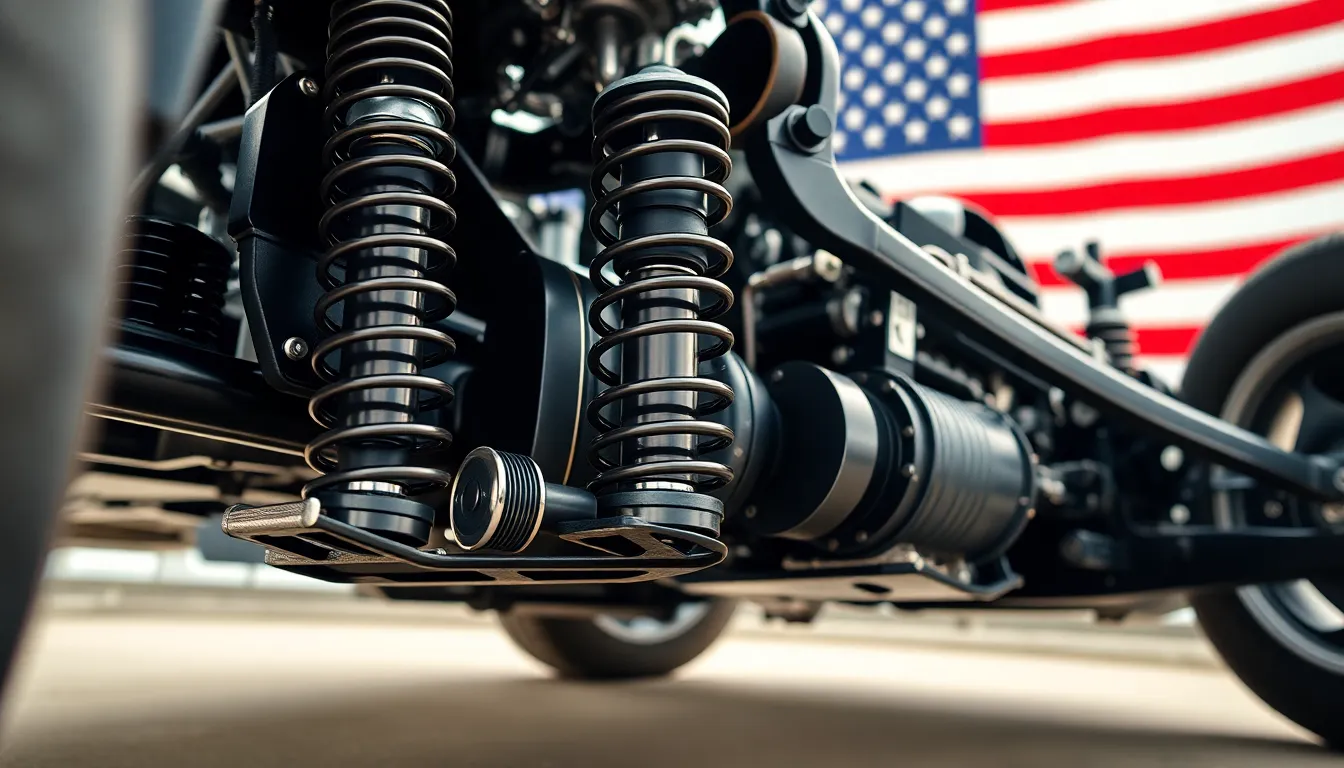Table of Contents
ToggleWhen it comes to racing games, few things can make or break a player’s experience like suspension tuning. In Forza, the right setup can turn a clunky ride into a corner-carving masterpiece. Imagine gliding through turns with the grace of a gazelle while your friends are still wrestling with their oversteering beasts. Sounds tempting, right?
Overview of Forza Suspension Tuning
Forza suspension tuning plays a crucial role in optimizing vehicle performance within racing simulations. Adjusting components such as springs, dampers, and anti-roll bars directly impacts handling dynamics and overall driveability. Players who understand these elements can refine their vehicle setups for specific tracks and conditions.
Spring rates affect how a car responds over bumps and during cornering. Softer springs provide comfort but may lead to body roll, while stiffer springs enhance responsiveness but can compromise ride quality. Adjusting damping settings controls how quickly a vehicle absorbs and reacts to road irregularities. A well-balanced damping setup improves traction, cornering stability, and tire wear.
Anti-roll bars control weight transfer during turns. Thicker bars prevent excessive body lean, enhancing cornering performance. Players can experiment with different settings to find the right balance between stability and agility.
Ride height tuning also influences performance. Lowering a car’s height can lower its center of gravity, improving handling. However, it risks bottoming out over uneven surfaces. Conversely, raising the ride height helps navigate rough tracks but may reduce aerodynamic efficiency.
Tire selection and pressure further affect suspension tuning. Different tires provide varying grip levels, impacting the car’s behavior under acceleration and braking. Correct tire pressure ensures optimal contact with the road, enhancing stability and performance.
Understanding and implementing these tuning aspects leads to a tailored driving experience. Through experimentation and adjustment, players achieve a setup that maximizes their vehicle’s potential on the racetrack.
Key Components of Suspension Systems

Suspension systems consist of various components that significantly impact vehicle performance. Understanding each part helps optimize tuning for enhanced driving dynamics.
Springs and Dampers
Springs support the vehicle’s weight and absorb shocks from the road. The choice of spring rates affects ride comfort and responsiveness. Softer springs offer a comfortable ride but may sacrifice handling precision. In contrast, stiffer springs improve stability and control during high-speed maneuvers. Dampers, or shock absorbers, control the oscillation of springs. Adjusting damper settings influences traction and stability. Properly tuned dampers minimize body roll, providing a smoother driving experience. It’s crucial to balance both spring and damper settings to achieve the desired handling characteristics.
Anti-Roll Bars
Anti-roll bars, also known as sway bars, help reduce body roll during cornering. They connect opposite wheels and distribute the force more evenly across the suspension. Increasing the stiffness of anti-roll bars enhances stability but may compromise ride comfort. A well-tuned anti-roll bar setup ensures better weight transfer management, promoting agile cornering response. Adjusting the thickness of these bars directly affects handling dynamics. Properly tuning anti-roll bars balances cornering abilities, eliminating excessive lean while retaining ride quality. Focus on the interplay between anti-roll bars and other components for optimal performance on the racetrack.
Benefits of Forza Suspension Tuning
Forza suspension tuning offers several advantages that enhance the racing experience. Players notice significant differences in handling and comfort with proper adjustments.
Improved Handling
Handling improves dramatically with the right suspension setup. A well-tuned suspension system ensures optimal tire contact with the road, enhancing grip during sharp turns. Adjusting spring rates and dampening settings helps achieve a balanced ride, allowing vehicles to respond more quickly to driver inputs. Weight distribution plays a critical role; when tuned correctly, it reduces body roll and improves cornering stability. Moreover, the correct ride height influences center of gravity, which contributes to better overall control. Players equipped with suspension tuning experience a noticeable increase in confidence, making it easier to navigate challenging racetracks.
Enhanced Comfort
Comfort also benefits from effective suspension tuning. A softer spring rate absorbs road imperfections, providing a smoother ride even on the bumpiest surfaces. Players appreciate the reduced vibrations and greater ease during long gameplay sessions. Stiffer dampers can enhance stability without sacrificing comfort, striking a balance that appeals to diverse driving styles. Proper tuning allows for personalized setups that cater to individual preferences, helping players enjoy both casual driving and competitive racing. Additionally, a well-tuned suspension system minimizes fatigue, ensuring more enjoyable and extended racing moments.
Tuning Techniques and Strategies
Effective suspension tuning in Forza encompasses several techniques that significantly impact vehicle performance. Two critical areas to focus on are adjusting ride height and fine-tuning damping settings.
Adjusting Ride Height
Adjusting ride height plays a crucial role in overall vehicle dynamics. Lowering the ride height can enhance aerodynamics, improving stability at high speeds. An optimal stance also lowers the center of gravity, resulting in better cornering responsiveness. Players often find that a lower ride height reduces body roll, allowing for sharper turns without sacrificing grip. Conversely, raising the ride height may improve clearance over obstacles and enhance comfort on uneven surfaces. Striking the right balance helps players tailor their vehicles to specific tracks and driving styles.
Fine-Tuning Damping Settings
Fine-tuning damping settings greatly affects how a vehicle responds to varying road conditions. Damping adjustments control the rate of spring oscillation, influencing ride comfort and handling precision. Softer settings absorb small bumps better, providing a smoother ride. On the other hand, stiffer settings enhance control during aggressive maneuvers. Players can achieve improved traction by balancing compression and rebound rates according to their needs. A well-tuned damping system also stabilizes the vehicle through corners, enabling quicker directional changes and enhancing overall driving confidence.
Common Mistakes to Avoid
Many drivers overlook the importance of proper spring rates in suspension tuning. Using overly soft springs can lead to excessive body roll, resulting in poor handling during sharp turns. In contrast, choosing springs that are too stiff may result in a rough ride, compromising comfort.
Another common mistake involves neglecting damping settings. Failing to balance the damping can cause issues such as loss of traction or instability. Drivers often benefit from adjusting rebound and compression settings separately, ensuring optimal control during acceleration and braking.
Not taking ride height into account leads to suboptimal performance. A low ride height might enhance aerodynamics but may reduce ground clearance, increasing the risk of bottoming out. Conversely, raising the ride height can improve obstacle clearance while sacrificing cornering effectiveness.
Players frequently misunderstand the role of anti-roll bars. Overlooking proper anti-roll bar tuning can result in excessive body roll, negatively impacting handling. Fine-tuning these bars is essential for achieving a balance between stability and comfort.
Ignoring tire selection also hinders suspension performance. The type and pressure of tires significantly influence grip and handling response. Selecting tires that match the tuning setup ensures maximum contact with the road and optimal performance.
Lastly, disregarding track conditions leads to mismatched setups. A configuration that works well on one track might not perform adequately on another. Adjustments based on track characteristics ensure a tailored driving experience that maximizes each vehicle’s capabilities.
Mastering Forza suspension tuning can significantly elevate a player’s racing experience. With the right adjustments players can transform their vehicles into agile machines that respond precisely to every input. Understanding the balance between springs dampers and anti-roll bars is crucial for achieving optimal handling dynamics.
Players should take the time to fine-tune ride height and damping settings to match their driving style and track conditions. This personalized approach not only enhances performance but also improves comfort during gameplay. By avoiding common pitfalls and focusing on the intricacies of suspension systems players can unlock their vehicle’s full potential and enjoy a smoother more responsive ride on the racetrack.




